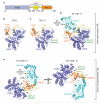Structural basis for autoinhibition and phosphorylation-dependent activation of c-Cbl
- PMID: 22266821
- PMCID: PMC3880865
- DOI: 10.1038/nsmb.2231
Structural basis for autoinhibition and phosphorylation-dependent activation of c-Cbl
Abstract
Cbls are RING ubiquitin ligases that attenuate receptor tyrosine kinase (RTK) signal transduction. Cbl ubiquitination activity is stimulated by phosphorylation of a linker helix region (LHR) tyrosine residue. To elucidate the mechanism of activation, we determined the structures of human CBL, a CBL-substrate peptide complex and a phosphorylated-Tyr371-CBL-E2-substrate peptide complex, and we compared them with the known structure of a CBL-E2-substrate peptide complex. Structural and biochemical analyses show that CBL adopts an autoinhibited RING conformation, where the RING's E2-binding surface associates with CBL to reduce E2 affinity. Tyr371 phosphorylation activates CBL by inducing LHR conformational changes that eliminate autoinhibition, flip the RING domain and E2 into proximity of the substrate-binding site and transform the RING domain into an enhanced E2-binding module. This activation is required for RTK ubiquitination. Our results present a mechanism for regulation of c-Cbl's activity by autoinhibition and phosphorylation-induced activation.
Figures





Comment in
-
Cbl exposes its RING finger.Nat Struct Mol Biol. 2012 Feb 3;19(2):131-3. doi: 10.1038/nsmb.2241. Nat Struct Mol Biol. 2012. PMID: 22301873 Free PMC article.
References
-
- Hershko A, Ciechanover A. The ubiquitin system. Annu. Rev. Biochem. 1998;67:425–79. - PubMed
-
- Pickart CM, Eddins MJ. Ubiquitin: structures, functions, mechanisms. Biochim. Biophys. Acta. 2004;1695:55–72. - PubMed
-
- Dye BT, Schulman BA. Structural mechanisms underlying posttranslational modification by ubiquitin-like proteins. Annu. Rev. Biophys. Biomol. Struct. 2007;36:131–50. - PubMed
-
- Deshaies RJ, Joazeiro CA. RING domain E3 ubiquitin ligases. Annu. Rev. Biochem. 2009;78:399–434. - PubMed
Publication types
MeSH terms
Substances
Associated data
- Actions
- Actions
- Actions
- Actions
- Actions
Grants and funding
LinkOut - more resources
Full Text Sources
Other Literature Sources
Molecular Biology Databases
Miscellaneous

